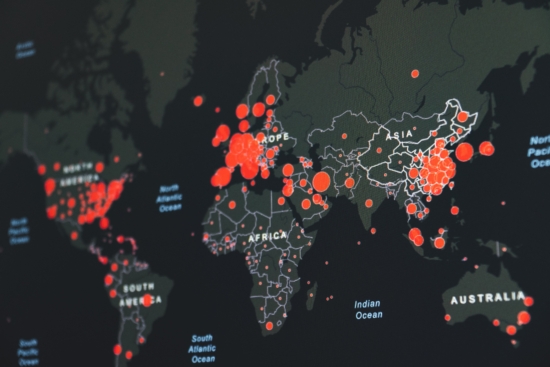China’s moves to relax zero Covid policies good news for the tyre industry
 While Covid has had a global impact, China’s particular policy choices have arguably had a more direct impact on the country’s tyre demand and production than others – an impact that the latest announcement appears to address (Photo: Martin Sanchez; Unsplash)
While Covid has had a global impact, China’s particular policy choices have arguably had a more direct impact on the country’s tyre demand and production than others – an impact that the latest announcement appears to address (Photo: Martin Sanchez; Unsplash)
On 11 November 2022, Chinese authorities issued a notice on how to proceed with the next phase of COVID-19 prevention and management. The statement’s content shows that the Chinese government is still adhering to the policy of “dynamic clearing”, but it has relaxed controls to a certain extent. And that’s good news for the tyre industry as one practitioner told us: “The fight against COVID-19 may not end in a short period in China. However, if the anti-epidemic policies in the next stage can reduce the negative impact on the economy, it will undoubtedly benefit China’s tyre industry.”
Balancing anti-epidemic and economic development
The impact of epidemic prevention and management on China’s tyre industry is enormous. The staffing shortage caused by the epidemic lockdown has seriously affected the production of tyre factories. For example, at the end of October, Guangrao County, one of China’s major tyre-producing areas, was sealed off for more than 10 days. Many sizeable local tyre companies were forced to stop and limit production during this period. Another example also happened recently. Indeed, one a large tyre manufacturing plant in Hefei, Anhui province, reports that they lost the production capacity of about 40,000 tyres in October due to the epidemic.
But it’s not just tyre production that is affected. The anti-epidemic policies have also impacted tyre market demand. Logistics services have been limited, which means truck tyre wear fell as truck and bus mileage decreased. Meanwhile, ordinary people had lower expectations for income, reduced unnecessary expenditures and became more cautious about consumption.
The policies announced by the Chinese authorities on 11 November can indeed alleviate the tyre companies’ difficulties to a certain extent. The behaviours strictly prohibited by the notice include “arbitrary suspension of production, blocking traffic without approval, arbitrary ‘silent’ management, arbitrary lockdown”. In addition, “during the outbreak of the epidemic, (government departments) must make every effort to ensure smooth logistics, and shall not arbitrarily require key enterprises that are related to the overall situation of the industrial chain and related to people’s livelihood to suspend production.” In these statements, “not suspend production” and “guaranteed logistics” are two keywords and are closely related to tyre production.
Other key points in the notice on how to carry out the next stage of anti-epidemic work include adjusting the setting of risk areas, delineating the scope of nucleic acid testing, and reducing the difficulty of entering China. Chinese authorities believe that the optimised measures can “balance the relationship between epidemic prevention and management and economic and social development.” China may implement the “dynamic clearing” policy for a long time. But the optimised policies are expected to free some people from some anxiety. As one business owner reiterated to Tyrepress: Confidence is worth more than gold right now.
Policy implementation less clear
Some entrepreneurs told Tyrepress that they still have concerns about implementing the policies. At present, the central government has simply published its policies. Observing when and how the local government will implement them will take time. Recently, the number of COVID-19 infections in various places has shown a rapid upward trend. Several tyre manufacturers are cautiously optimistic about the following situation.
Tyre manufacturing employees sanitise their factory (Photo: Bayi Rubber)
A tyre manufacturing base in southern China has recently raised its canteen’s inventory standards, stocking ingredients that can be used for more than five days. It is reported that the city where the base is located has recently seen multiple cases of COVID-19 infections. Reserve food in advance can prepare for closed-loop management that may come at some point. “Closed-loop management” is a model commonly used by Chinese companies in the past two years. In areas with severe epidemics, factories close their factories to be able to produce and require workers to live inside the factories to reduce direct contact with the outside world. At the end of October, some tyre factories in Guangrao adopted this model for more than ten days.
The situation in Guangrao shows that there is still room for improvement in the closed-loop management model. For enterprises, implementing this model requires taking into account both anti-epidemic and production operations, which significantly increases the management difficulty and operating costs. In addition, implementing closed-loop management is sometimes a short-term decision. Some companies rushed to implement this strategy when the supply of living materials could not be delivered on time, causing many workers to complain. One worker who has experienced closed-loop management in Guangrao told Tyrepress: “During the closed-loop management period, the factory did not distribute supplies except a pack of masks. The food in the canteen was expensive.” Another witness said he only ate noodles and instant noodles for more than 10 days. The original intention of closed-loop management is to maintain normal production operations. In the next period, by optimising various policies and accumulating anti-epidemic experience, the tyre company may improve the supply system supporting closed-loop management.
In general, China has relaxed the COVID-19 prevention and management policies this time, which is conducive to developing the country’s economy, restoring the vitality of the manufacturing industry, and revitalising the people’s confidence. However, in today’s repeated epidemics, how to implement these policies in various places will be a test of governance capacity for governments at all levels.




Comments